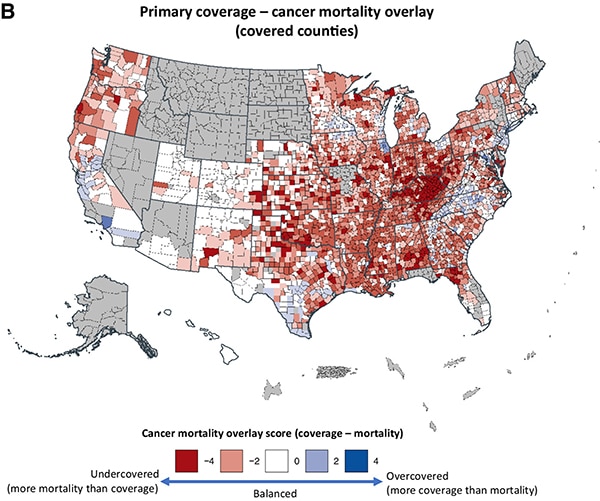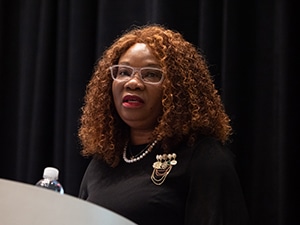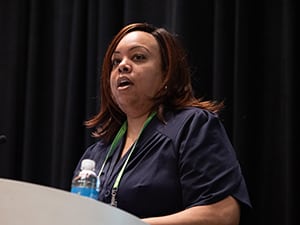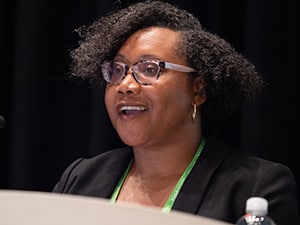According to a study that looked at the catchment areas of 102 cancer centers in the United States, 15 % of counties are unprotected, despite the fact that more than one-third of the country’s counties have at least one cancer center.
The authors of the study, which was published in the AACR journal Cancer Epidemiology, Biomarkers & amp, Prevention, stated that” the most unsettling finding from this study may be the large number of Americans who are residing outside of a cancer center primary catchment area.” In the Appalachian and Southern United States, where cancer disparities have historically been significant and still exist, undercoverage appears to be at its highest. Patients in these areas are less likely to start receiving prompt cancer treatment, to have poorly informed beliefs about cancer screening and prevention, and to sign up for clinical trials.

Such data highlight the challenges cancer centers may encounter when working alone to effectively treat underserved U.S. populations. A crucial step in making sure that patients enrolled in clinical trials resemble the patients who will receive the new treatment is involving community partners and neighborhood hospitals that serve populations that are geographically, racially, economically, and socioeconomically underrepresented.
Presentations from the AACR Annual Meeting 2023, which took place from April 14 to 19, on reshaping clinical trial design to make it easier to enroll patients from underserved communities in clinical trials, were included in part one of this blog series. Effective community engagement strategies covered at the meeting will be highlighted in this second and final section.
Best Methods for Participating in the Community
At a forum titled” Beyond Platitudes and Proclamations: Meaningful Engagement of Diverse Communities in Cancer Research ,” session chair Monica Baskin, PhD, an associate director of health equity and community outreach and engagement at the University of Pittsburgh Hillman Cancer Center, explained that building trust and credibility is the first step in the community engagement cycle. To further increase credibility and trust, additional steps like comprehending the community context, communicating bidirectionally, and making sure that participants in the research see the results are taken.
Massive trust breaches, like the Tuskegee syphilis study and the Puerto Rico Oral Contraceptive Trial, do not fully depict the systemic injustices in clinical research, according to ScD, MPH, Erica Warner, assistant professor in the Department of Medicine at Harvard Medical School and assistant investigator at Mass General Hospital.

” Sometimes when we reflect on history, we do so in a way that makes these events seem distant— something that happened in the past and is now over.” However, she added that there are still ongoing activities, policies, and events that make us and our organizations potentially unreliable.
These practices include transactional relationships, in which researchers only interact with the community to recruit participants for clinical trials and fail to share the trial’s findings with those communities, an influx of researchers into the field due to its current popularity who lack experience in health equity research, and the failure to recognize a community research site as its full partner, which occasionally results in power disparity and restricted resource sharing.
Warner emphasized that researchers must be aware of a community’s needs and critically assess whether their study will actually benefit the community in order to ensure that interactions avoid these pitfalls. She also suggested that trustworthiness should be assessed and monitored over time so that researchers can determine which methods are effective and which are ineffective.
At the NYU Grossman School of Medicine, Jiyoung Ahn, a doctor, a professor of medicine and population health, shared strategies that influenced how her team interacted with Asian Americans.

In order to investigate the connection between gut microbiota and human disease in a population of more than 50 % Asian Americans, the Food and Microbe Longitudinal Investigation ( FAMiLI ) study was started. Ahn and colleagues established a community advisory board early in the study, which served as the community’s liaison with the researchers and reviewed all plans and materials.
Asian Americans were particularly receptive to the notion that their participation in clinical trials was a gift they could give to future generations, including their own children, according to Ahn and colleagues’ research on recruitment. The researchers also made use of WeChat and KakaoTalk, two social media sites that are well-liked by Asian Americans.
All surveys and instruction manuals were translated and culturally modified to accommodate an Asian American population for data collection. Ahn and colleagues used brief, adaptable questionnaires that could be filled out on paper, in a web browser, by text, or by email and saved for later use if necessary. They used at-home collection kits with pre-paid labeling for return to the lab for sample collection.
These ideas could be broadly applied to a wide range of other racial and ethnic groups, according to Ahn.
Outreach to the Community in Action
Experts from the AACR Minorities in Cancer Research constituency group discussed institutional and governmental initiatives to promote collaboration between cancer researchers and underrepresented communities at a Scientific Symposium on Innovation to Address Disparities of Oncology Clinical Trials.
The session’s cochair and head of the Division of Solid Tumor Oncology at Memorial Sloan Kettering Cancer Center, Luis A. Diaz Jr., MD, FAACR, began by outlining the glaring injustices in the way clinical research is carried out and healthcare resources are allocated. There are significant differences in clinical trial participation in underrepresented populations despite this enormous infrastructure — literally billions of dollars — to support the medical research cycle, he claimed.

At the Mayo Clinic in Florida, Folakemi Odedina, PhD, cochair of the session, professor of internal medicine, and associate director for the Center for Health Equity and Community Engagement Research, discussed a solution she and her colleagues have spearheaded:” We have to make clinical trials an interaction.”
The Community Clinical Trials Champions Program has helped Mayo Clinic establish connections with churches, mosques, fraternities, American Legion posts, and other similar organizations to inform patients about clinical trials. In order to be informed in the future about clinical trials for which they may be qualified, they ask people during their outreach if they would like to sign up for a community research registry.
Odedina talked about other strategies for increasing the number of people who could participate in clinical trials, such as opening clinical trial offices or recruitment stations in densely populated areas where anyone interested in participating can stop by, ask questions, and sign up for the registry. In order to help patients who are unable to travel to the main research site, she also mentioned mobile research units for collecting clinical samples.
According to LeeAnn Bailey, PhD, MBBS, director of the Center to Reduce Cancer Health Disparities at the NCI’s Integrated Networks Branch, the National Cancer Institute( NCI ) has a similar set of engagement programs.

The CATCH-UP program, which provides access to targeted cancer therapy for underserved populations. Eight NCI-designated cancer centers with a track record of involving minority populations to assist in recruiting people from underrepresented groups into clinical trials testing targeted cancer drugs were given awards by the 2020 program. Studies to test culturally adapted recruitment strategies to entice more patients from underrepresented racial and ethnic groups into clinical trials are similarly funded by the Connecting Underrepresented Populations to Clinical Trials ( CUSP2CT ) program.
According to Bailey,” You can’t affect enrollment or recruitment downstream without referral or engagement.”
Bailey also talked about the National Community Oncology Research Program( NCORP ), which runs clinical trials in areas like screening, prevention, surveillance, supportive care, and quality of life related to health. The program’s stated objective is to” bring people in their own communities” to participate in cancer clinical trials and care delivery studies. They recruit a wide range of patients for clinical trials run by various NCI programs through their network of 46 community sites, 14 of which serve at least 30 % underrepresented minorities.
According to Jamie Brewer, MD, a medical oncologist and acting Clinical Team Lead in the FDA’s Office of Oncologic Diseases, the U.S. Food and Drug Administration ( FDA ) runs programs to promote the inclusion of underserved patients outside of racial and ethnic minorities.
According to Brewer,” diversity should be taken into account across demographic characteristics like race, ethnicity, age, geography, and clinical characteristics that may affect treatment outcomes or responses, such as hepatic or kidney dysfunction.”

Brewer mentioned Project Silver, which aims to increase the number of cancer patients — of 65 and older — who are frequently left out of clinical trials for the disease. Brewer also talked about Project Community, a program that supports rural cancer patients, survivors, and advocates.
According to Brewer,” it is entirely focused on relationships — creating relationships, offering information to the community and the populations affected by cancer.” ” We really want to establish long-term connections and a channel for outreach and communication with Project Community.”
You can browse the sessions chosen for the Cancer Disparities track here for more details from the Annual Meeting on health disparities and the value of diversity. Through July 19, 2023, registered meeting attendees will have access to recordings for each session on the virtual conference platform.
Additionally, registration for the 16th AACR Conference on the Science of Cancer Health Disparities in Racial / Ethnic Minorities and the Medically Underserved is now open.
The first publication of the post-AACR Annual Meeting 2023: Boosting Diversity in Clinical Trials ( Part 2 ) Community Engagement was made public by the American Association for Cancer Research.

